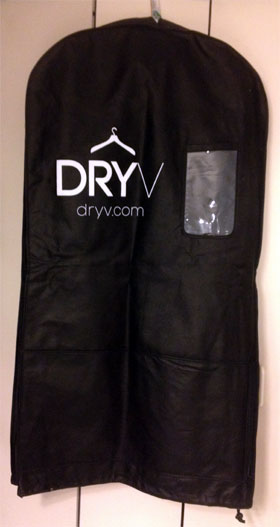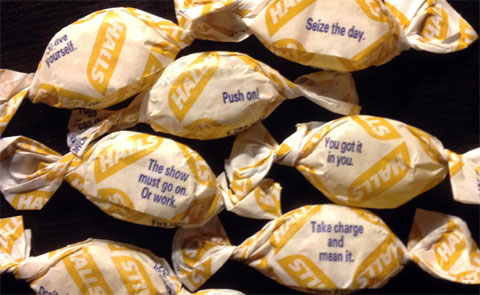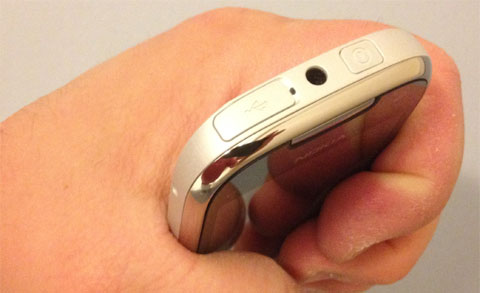Dryv Dry Cleaning And Laundry Delivery Service Is What I’ve Needed
 You could call the recently-launched Dryv dry cleaning and laundry on-demand pickup and delivery service disruptive to the market. You could call it a game-changer or any analogy to a new business in an established market. For me and my lifestyle, it simply makes sense.
You could call the recently-launched Dryv dry cleaning and laundry on-demand pickup and delivery service disruptive to the market. You could call it a game-changer or any analogy to a new business in an established market. For me and my lifestyle, it simply makes sense.
Read on – if you think it’s worth a try, at the end of this post is a discount code for Dryv.
Over New Year’s I heard some chatter on Twitter about Dryv, and I couldn’t wait to try it out. If it was all that it sold itself as, then it would work perfectly for me. What I heard was it is an on-demand service which, when requested through its mobile app, will come and pickup your dry cleaning and when it’s ready, you can request again through the app to have it delivered to you.
Living in downtown Chicago there are many advantages and as well many compromises that I have had to make over the years. Being so close to Millennium and Grant Park is awesome, yet for years we did not have a decent supermarket nearby until Mariano’s opened a couple of years ago. For dry cleaning, or more often simply laundering and pressing of dress shirts for work (something I have never mastered), I have been on a continual quest for a decent dry cleaner close-by. The ones I had gone to were usually in the basement of an office building, with limited hours that I would often miss and as a result have my clean clothes locked away. As my residence building doesn’t have a doorman or common areas, the notion of any other delivery service wouldn’t work for me.
A Service I Don’t Want To Think About
When it comes to dry cleaning or laundry service, I really don’t want to think about it. Since I have lived in Chicago I have had to. Before I moved here and lived in the suburbs of Boston, I had one local dry cleaner, literally at the end of my street. My schedule allowed me to get to them without any problems and their service was good. It was a service I didn’t need to think about. With the minor inconvenience in dry cleaning for me, if I were to go with a replacement, I would want that level of “comfort” of not having to think – or worry – about it.
Before I tried Dryv, I checked out their Web site and contacted them on answers that weren’t there. They promise to come on-demand within an hour of a request for drop-off and pickup. They use commercial dry cleaners who serve hotels and restaurants in Chicago. Their prices are comparable to other dry cleaners I have used. And last but not least, they will take back my unused wire coat hangers – I never use them and have always brought them back with my next order! This gave me the confidence to try them.
Simple User Experience With Mobile Email and Humans
After getting the app installed on my phone, I set-up my profile, home address and credit card for payment, then requested a pickup by creating a new order. The app itself is very simple – you place the order through it, and in combination with text messages your order is confirmed and you are alerted when the Dryver – the person who picks up your order – is on their way. When you meet them, you give them your clothes and any instructions for cleaning. Later when your order is processed you will receive an email confirming the order and the cost. When your clothes are clean and ready to be delivered – promised within 36 hours – you will get another text message. At that point you then go into the app to request a delivery. The app allows you to store multiple addresses, so you could, say, have pickup at your office and delivery to your home.
When your clothes are returned to you, they are in a nice Dryv reusable garment bag as pictured in above in this post, and inside the clothes are covered in traditional plastic bags you would get from any dry cleaner. You can then use the garment bag for future orders to give the clothes to the Dryver, plus hangers if that is your thing.
It really was that simple and easy, and after the first order I have now used them a total of 4 times, which is a volume normal for how often I get cleaning done. My orders are mostly shirts, occasional pants, and nothing too complex.
A Growing Service And A Few Thoughts
My original order number was under 100 and my latest one is in the 300’s so Dryv is definitely growing. Where originally they only offered traditional dry cleaning and wash and press service, they are now offering a laundry service by the pound. They have had a few updates to their app since they have started, plus they have added an FAQ and other details to their Web site. Not bad for a service that has only been around a couple of months.
Though they are still new, I would be remiss if I didn’t share any thoughts and suggestions on the service and their technology. Currently the app is only available for iOS, and adding an Android and Windows Phone option would be beneficial to them. As for the features of the app, it would be great to be able to not only request the pickup but enter into the app what you are dropping off as well as any instructions. I typically put a piece of paper with what I have and how I like my shirts done, but using the app for this would be key. And when my order is ready, if the icon on the app had an “alert number” as a reminder that would also be helpful, as sometimes the text message gets buried by the other text messages and alerts I receive. I would also suggest them to expand more into the South Loop neighborhood of Chicago.
Try Dryv For Yourself Chicago And Save $20
As you can guess, I recommend Dryv, especially as they have been picking up and delivering with no problems in the horrible weather we have had in Chicago the past few months. As I am customer, they offer a unique referral program, where if you use the code 6H1A you can get $20 off your initial order. Note I would also get a similar savings if you use that code, just so that I am being completely transparent. I don’t have any other tie to Dryv, I am only a happy customer.
I welcome your thoughts in the comments of this post on Dryv and if you have used it or are not sure if you would use it.
This is from The Hot Iron, a journal on business and technology by Mike Maddaloni.
Did you enjoy this? Subscribe to The Hot Iron by RSS/XML feed or Read by Email.
Business • Mobile Technology • Strategize • Technology • (0) Comments • Permalink
What I Learned This Week For February 7 2014

Now 2 days late, but hopefully still of some value to some of you, as most were to me. These were scrawled on the back of an envelope for a credit card offer, adding some real value to this junk mail.
- Boundaries are not always bad, and when people tend to be pushing them, sometimes they are simply asking for them to be defined to them.
- Halls cough drops have little motivational phrases on the wrappers. Not a bad idea for if you are buying cough drops, you are probably not at the peak place in your life.
- There is a distinct difference between MOO MiniCards and Mini Moo’s.
- Perform a Web search on any word or phrase, followed by the word “coloring” and you can find a plethora of coloring sheets for kids to color on.
- There was little coverage outside of the tech world on the theft and compromise of the Twitter account @N by a social hacker. If you are not familiar with the term social hacker, look up anything on Kevin Mitnick. This article on The Verge about the @N theft and how the owner’s GoDaddy and PayPal accounts were compromised also includes a link to the Twitter account’s owner’s own story.
- Where that famous groundhog in Pennsylvania saw its shadow and predicted a longer winter, my forecast has always been with Dunkirk Dave who hails from the same Western New York State city that I was born in. And it has nothing to do with him not seeing his shadow, and thus predicting an early spring.
- I began taking an online course on “unprocrastination” and one of its tasks is to create a habit and commit to it. So I decided to come up with a new blog topic every day (not write it, just the topic) and I am also sharing it with the world. Look on Twitter for the hashtag #28d28bt for my topics. More on the course itself as I get into it.
- A documentary on learning how to be a pit trader in the famous Chicago markets was just released this week, though it was filmed in 1996. Pit Trading 101 was released only online, and for US$2.99 you can see a training course on how those people who are yelling, screaming and flailing their arms are actually conducting business. It was released by Chicagoan and former trader Jonathan Hoenig who is also in the documentary. I haven’t watched it yet but want to, not only to understand how the heck that process works but also to seeing a piece of this city’s history. Below is an embed of the movie’s trailer or you can watch it on the documentary’s Web site.
This is from The Hot Iron, a journal on business and technology by Mike Maddaloni.
Did you enjoy this? Subscribe to The Hot Iron by RSS/XML feed or Read by Email
Blogging • Business • Strategize • Technology • What I Learned • (0) Comments • PermalinkThe Lack Of Women In Technology And Why I Don’t Touch Type

There has been a lot of talk and activity about encouraging more young women to enter the technology fields, whether engineering or software or any technical role. Much of the reason for the outside effort is that girls and young women are not typically encouraged to enter these fields.
When I first started hearing about these kind of efforts, I was initially surprised, namely as I have had the good fortune to work with many women over the years in software development and Web technology. Where when many think of the traditional “geek” it is a guy, there have been many women I would also consider geeks, and if I told them to their face, they would probably agree with me!
Perhaps maybe I am an anomaly, for as I pull back and see the big picture, I do see there are many more men in tech, whether it’s in the leadership within a company or within the industry overall. I haven’t studied this area in great detail as to statistics or even why there may be people discouraging women from getting into technology. For the more I think about it, I am not surprised that teachers, guidance counselors or even parents or family may discourage someone from taking classes in a subject area, as this was something I encountered myself.
I Don’t Know How to Touch Type
All that you are reading here, including the infrastructure and front-end code that presents my writings here on The Hot Iron, were entered into a keyboard with just my index fingers, plus my thumbs on the spacebar. Seriously, I don’t know how to touch type, and not only did I never take a class in high school to learn how to, but I was encouraged not to.
Though I was using computers back in junior high school, had my own computer at home and even did my first consulting gig for the assistant superintendent of my school system plus it was overall no secret I was into computers, the fact I should probably learn to touch type did not come naturally to my guidance counselors in high school. Their reasoning? As I was on the “college track” in high school, this was not a recommended course to take, and typing – which was offered in school – was encouraged for those not going into college and rather right into the workforce. Seriously, that was the thinking in the early 1980’s. I never did fight this, for by that point I had been typing this way for several years now.
Don’t get me wrong, this is not anything that has ever haunted me as a decision. I have managed to get by with just 40% of my digits on the keyboard and I am actually quite quick at typing this way. The reason why I remember this is because people, upon watching me type, will always ask me why I don’t touch type. As the question comes up almost as frequently as to why I sign my email messages as I do, it is a story that is readily accessible. Over the years I could have taken a typing class but never even made an effort to do so, as I am not sure how much different it would have made. Of course I am not saying this “guidance” led me down a different path, but it is a small example of the types of influences that are out there.
Expose To Most All, Let Them Decide
The more I think of this effort, the more I believe in it. As a parent, I don’t want to purposely hold back my kids from any career or activity decision, providing I can afford it. Though this is nothing I am worried about now, for right now my oldest first needs to learn to read, and my youngest needs to finish potty training! But by the time they are older, hopefully there won’t be a need for organizations like Ms. Tech and the many others, for opportunities will be chosen based on your interest, not negative outside influences.
I welcome you to share any stories – positive or negative or even anecdotal – on this subject in the comments to this post.
This is from The Hot Iron, a journal on business and technology by Mike Maddaloni.
Did you enjoy this? Subscribe to The Hot Iron by RSS/XML feed or Read by Email.
Strategize • Technology • Thrive • (4) Comments • Permalink
Controlling Your Own Destiny With Technology, Revisited
Over 5 years ago I wrote here on The Hot Iron about controlling your own destiny or controlling as much of it as possible. If you read (or re-read) the article, I was looking at this topic mostly from the point-of-view of working with external technology vendors and what happens when one doesn’t live up to expectations or even shuts down.

Fast-forward to 2014, and my lens on this topic has changed dramatically. Where then I was talking about control you had over external entities, now I am thinking of my needs and my information and if I even need external entities at all.
As time goes by businesses online come and go, or in some cases specific services from those businesses. From GeoCities to Posterous to Nokia Ovi to you name it, one day something you are using is gone the next, and hopefully you don’t lose tangible assets – e.g. data, photos, documents, etc. – in the process. Granted losing sleep, your temper or clumps of hair are collateral damage of this type of situation.
Add to this the overall uncertainty of technology and business, not to mention the ever-changing terms of services from vendors that may change to your disadvantage, or truly not knowing what is “behind the curtain” with a service or who or what has access to it, you may end up in a situation fast where you need to quickly change course.
So what do you do? Where every situation is unique, I’d like to share the path I am taking these days when it comes to online services.
Tell me what you want, what you really, really want
In short, that whole “goals” thing again! Having a goal, purpose, mission statement or random scribbles on a napkin can help guide you through the choices you make, In addition to the goal, think about other controllable factors, such as budget, timeline and how much time you have to invest initially as well as on-going. These factors can also influence your decision, no matter the goal.
Once you have gone through the goals and review process, and have made choice, pat yourself on the back, then plan for what happens if you have to make another change. As this change could occur next week or in the next decade, you don’t need a detailed, point-by-point plan, but you do need some information, such as contact, license, login and how you are using or customized the service. From there, determine how and to what extent you can extract data or information from the vendor or service, both for a final move or on a regular basis for off-site storage.
The Path of a Service Change
A couple of years back, after my several times a day ritual of reading what was new in the world in my RSS reader, Google Reader, I started to think about how I was reading, not what, and if there was a better way.
Google Reader, for those who don’t know, “was” a free RSS feed aggregator and reader from the search giant. It was a very popular service, but one that was slow to innovate. Despite this, I had over 200 RSS feeds subscribed to thru Google Reader, and it was my primary source for news and information, both on the world around me as well as technology, sports, and other topics of interest.
What I realized was quite simple – Google, or anyone who had access to the data stored in the Google Reader service, knows everything I read. Everything.
The more I thought about this, the more my decision became clear. There must be another way for me to aggregate and read RSS feeds where I have control of my destiny – the software, the service and most importantly the information. As I searched I found a variety of hosted services and software I could run myself. After some analysis and a personal recommendation from my good friend John Morrison, I went with Fever and have never looked back.
Fever is a self-hosted RSS reader developed by Shaun Inman. For just 1 person running the entire operation, Fever is a quality product. It is a paid license and is probably the best US$30 I have ever spent. With Fever I could get the same features I got from Google Reader, with a much more stylish Web interface, including a mobile-optimized experience for the iPhone’s Safari browser. It has a “hot” topic feature that I have never used and really can’t talk to, for the main functionality has suited me perfectly.
My migration from Google Reader to Fever meant installing the latter on a Web hosting service I use, then migrating the feeds from Reader to Fever. This step, though very straightforward, requires some knowledge of how a Web site with a database is setup and configured. For migrating the feeds, I could have automated the process and extracted all feeds and uploaded them into Fever. However I chose a manual process as I had not really taken a close look at all of the feeds I was subscribed to, and as a result I culled the collection by about 50 feeds, many which were no longer feeding any content at all.
In mid-2013, Google shut down its Reader service, causing an uproar from many, but not from me. By that point, I had been off of Reader for over a year. Google gave a long lead time to switch to any other service, which is now always the case. That being said, having control of the service means you own the information as well as how you access it.
Always Looking
As new methods, products and service become available, it is important to spend some time evaluating services. Reading and research alone are not enough, a stalking with friends and colleagues also help expose you to options as well as first-hand accounts of their utility.
Where in the past I have used services like Google Reader, Basecamp, Blogger and Google Calendar, today I am using Fever, ActiveCollab, ExpressionEngine and ownCloud respectively. I plan to talk more about some of these services in the future. But this is my list now, and it is subject to change without much advanced notice!
Have you yourself changes services or rolled your own, or is it something you don’t see yourself doing at all? I welcome your thoughts and questions in the comments of this post.
This is from The Hot Iron, a journal on business and technology by Mike Maddaloni.
Did you enjoy this? Subscribe to The Hot Iron by RSS/XML feed or Read by Email.
Strategize • Technology • Web Development • (2) Comments • Permalink
3 New Year’s Resolution for Digital Marketers
 Editor’s Note – This is a guest post from CT Moore, a recovering agency hack who helps brand leverage search and social media to meet their business goals online. By day, he heads up Search and Social at Publikit, a boutique web dev agency in Montreal, and also runs Socialed, a digital consultancy that provides digital strategy to both start-ups and multinational brands alike. You can find out more about him through his personal blog.
Editor’s Note – This is a guest post from CT Moore, a recovering agency hack who helps brand leverage search and social media to meet their business goals online. By day, he heads up Search and Social at Publikit, a boutique web dev agency in Montreal, and also runs Socialed, a digital consultancy that provides digital strategy to both start-ups and multinational brands alike. You can find out more about him through his personal blog.
Aha! Another year is about to come to close and a new one will soon begin. And if you’re any kind of marketer (or business person for that matter), you’ve probably started thinking about what you could start doing in 2014, or at least do better in 2014 than you did in 2013.

Well, if that’s the mind frame you’ve been in, I’d like to suggest 3 potential New Year’s Resolutions that you should probably apply toward your upcoming marketing efforts. I have to warn you, though: if you’ve already made up your mind on how to tackle things in 2014 and aren’t open to feedback, you should probably read no further — I’ll just end up saying “I told you so” ;)
#1 OWN Your Media

Paid media is the placement you pay for: ads, commercials, etc. Earned media is the PR and social media wins you get from doing awesome stuff and providing great customer service.
Owned media, however, is the stuff you produce that people actually care about. In fact, what kinda of makes it “media” is that people actually pay attention to it (unlike ads). It can be anything from just really helpful how-to’s to outright entertaining viral stuff, but the point is that it gets you exposure with the right target market, just like PR or advertising would.
The only difference is that you made it. And right now, 78% of CMOs believe that branded content is the future of marketing, with 25% of budgets going to content. So in 2014, start thinking about how to own your media.
In fact, start investing in media worth owning. Because, at the end of the day, content is a lot like tattoos: it can be either cheap or good, but not both.
Good content costs money to make, and you have to keep at it for a while before it pays-off; but when it pays-off, it really pays-off. From branding to public relations to SEO, it’s one of the few channels that also contributes something to all the other channels.
#2 Get Serious About Mobile
 Yeah, I know: a lot of you think you’re serious about mobile? But are you really? I mean, are you anywhere near the companies whose marketing you admire/envy, and/or can you actually implement the kind of strategies they have going on??
Yeah, I know: a lot of you think you’re serious about mobile? But are you really? I mean, are you anywhere near the companies whose marketing you admire/envy, and/or can you actually implement the kind of strategies they have going on??
Now, I could dig up a bunch of stats and quote them to create urgency and make you sympathetic to my point. But, instead, I’ll just guess (i.e. “assume”) that enough of you reading this have smart phones (and are sufficiently attached to them) that I don’t need to do that kinda thing. So let me leave you with a kind of barometer / checklist to figure out just how the eff you’re supposed to tackle mobile in 2014:
- Mobile Sites: I’m still shocked by just how many top-tier companies/sites/portals fail at this. If you don’t have a mobile site, get one. And if you already have one, make sure that I’m redirect to it if I visit your site from a mobile device.
- Mobile App: If your business is driven by user-experience (e.g. commerce) or content, release that App already! No repeat customer or returning user wants to deal with your mobile site. And even here I can think of a few content portals who have an otherwise great mobile engagement strategy but no mobile app…
- Mobile Campaigns: If you’re already investing in display ads, PPC, and/or SEO, start looking at how you can divert some of that toward targeting mobile users; there are enough of them using mobile apps and searching via mobile devices that you can’t afford no to.
Okay, so you get the point? Good! Let’s move on….
#3 Start Listening to Your Customers
 So maybe you’re already doing the mobile and content thing, or may you’re not but (hopefully) are gonna start. Either way, you’re going to have to measure your progress. And, of course, you’re going to be measuring and monitoring what user actually do once they engage with your brand.
So maybe you’re already doing the mobile and content thing, or may you’re not but (hopefully) are gonna start. Either way, you’re going to have to measure your progress. And, of course, you’re going to be measuring and monitoring what user actually do once they engage with your brand.
But are you being proactive in that measurement? In other words, are you actually trying to gage how your users specifically and the market at large feel about your industry?
For starters, start looking at what people are already saying about both you and your competitors. Tools like Salesforce Marketing Cloud are great for this kind of thing. They let you monitor not only your brand name but what people are saying about your industry and competitors, in general.
Step it up a notch, though, by finding what your actual user and site visitor think. There are a few service providers that can help you do this, but the (ubiquitous) one that comes to mind is iPerceptions. You’ve probably come across them in the form of their 4Q survey, which is a free tool. But they also offer a bunch of voice of customer measurement tools you can upgrade to to make sense of the data that you collect via the 4Q survey.
The point is (1) stop assuming you think you know better than your (potential) customers, and (2) stop looking at what your users might’ve done and start considering what they’re actually looking for. Because that’s the kind of insight that’s not only gonna help you step up your marketing game, but develop better products and services, the likes of which you might’ve not otherwise considered…
New Year, New Start
If you’ve read this far, I want to make one thing clear: I’m not saying you have to follow my advice. I’m just saying you should.
You’re free, of course, to disregard my advice, but I’m confident enough that you’d be wrong to do so that I wrote this blog post and put my name on it. So give it some thought; sleep on it; and do whatever it is that you have to do to “tear sh*t up” in 2014 that you’ll be too busy either optimizing some version of your site or developing new product/service that you won’t give this post another thought ;)
This is from The Hot Iron, a journal on business and technology by Mike Maddaloni.
Did you enjoy this? Subscribe to The Hot Iron by RSS/XML feed or Read by Email.
Business • Guest Post • Mobile Technology • Strategize • Technology • Thrive • (0) Comments • Permalink



